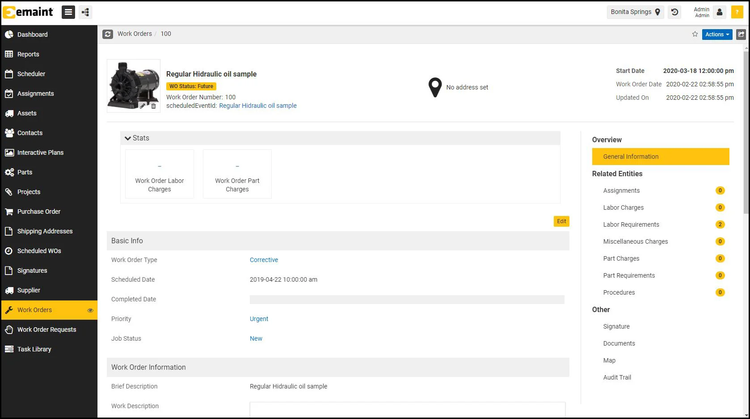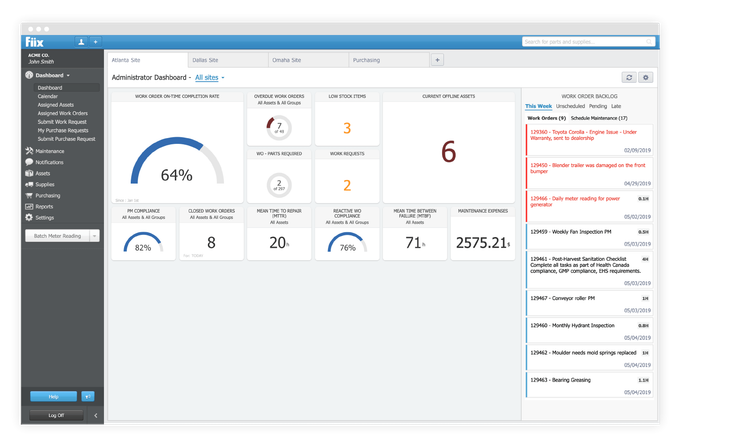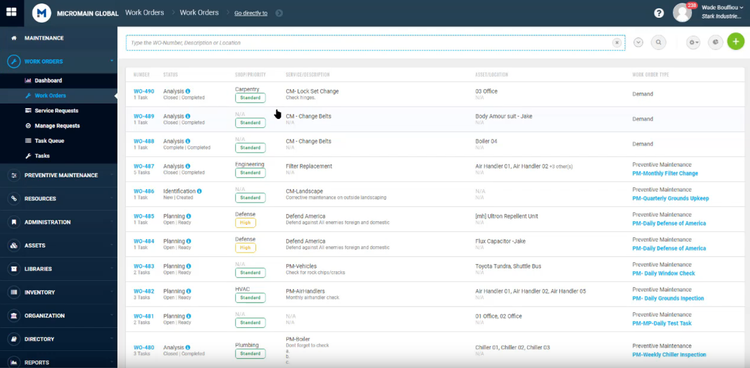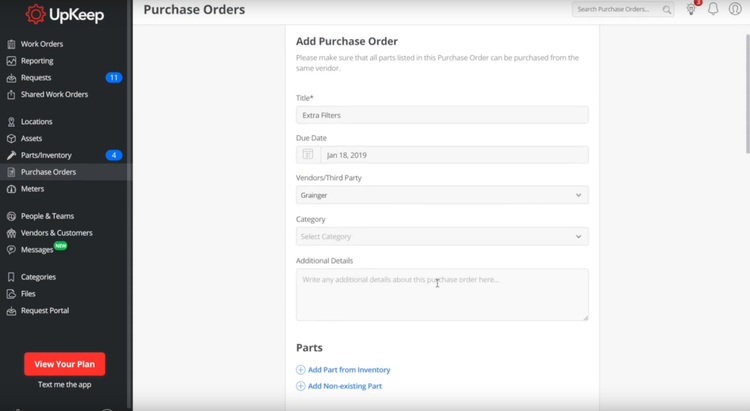What is a Work Order? A Guide on How They Are Used
A work order is a document or request detailing tasks, materials, and instructions needed to complete a specific job or project. Sometimes called job orders or service orders, work orders are the lifeblood of your maintenance department. They outline:
- What workers need to do and in what order
- Follow-up actions from inspections and audits
Work orders stem from customer requests or are created internally. They’re a core part of computerized maintenance management systems. CMMS software automates the work order process by allowing for job tracking, recurrent scheduling, reporting, and closing of tasks. This type of tool is a key part of an organization’s maintenance operation—as work orders help maintenance managers and technicians organize, assign, prioritize, track, and complete key tasks.

Work orders can also be created through dedicated work order software that offers a variety of work order templates and a request/approval process.
The functionality offered by a work order management system includes:
- Order creation: Includes templates and guided tools
- Requests: Allow different employee levels to submit work order requests and route them to the appropriate manager or technician for approval
- Scheduling and resource allocation: Identify what equipment and materials are required to complete a job and/or the employee qualified for the work. Cross-reference schedules to ensure a repair time works and avoid double-booking
- Change orders: Make changes to active work orders after it’s already been approved or created
- Completion monitoring: Track job completion in real time. Benchmark key intervals in task completion and accurately predict work completion.
- Reporting: Monitor key performance indicators on completed work, such as error rates, adherence to quality standards, and time to completion. See who has performed the work, what equipment was used, and how improvements could be made. Export data to spreadsheets.
The Work Order Lifecycle
- Work Request Submission: A user submits a work request to report an issue or schedule maintenance.
- Work Order Creation: A maintenance manager approves this request and creates a formal work order with job details, resources needed, and assigned personnel.
- Approval Process: A supervisor authorizes the work order based on priority, cost, and complexity.
- Scheduling and Assignment: The manager schedules the work and allocates resources like equipment, parts, and labor.
- Work Execution: The assigned team completes the tasks detailed in the work order.
- Review and Completion: Once the work is complete, the manager reviews the work order to ensure all tasks were completed correctly.
- Documentation and Closing: The technician or manager records documentation of the completed work and closes the work order in the system.
- Post-Completion Analysis: The manager can generate reports to analyze the work for costs, efficiency, or future improvements.

Best Practices
- Be Specific: Describe the task clearly, including the location, required tools, and detailed instructions. This will help reduce any miscommunications or delays.
- Prioritize: Assign priority levels to each work order so urgent tasks get completed first and resources are used effectively.
- Set Realistic Deadlines: Specify accurate timelines for when the task needs to be completed to manage expectations and keep projects on schedule.
- Attach Documentation: Include schematics, checklists, manuals, photos, and safety checklists to assist the technician.
- Assign Technicians: Appoint personnel with the right skills, certifications, and availability for the job.
- Review: Verify that all information is correct before issuing the work order; double-check job details and needed resources.
- Use Software: Utilize CMMS or work order management software to automate generating, tracking, and assigning work orders.
- Follow Up: Schedule recurring tasks or further checks to avoid missed maintenance or unfinished work.
When Do You Need Work Order Management?
For the most part, you’ll be handling maintenance requests either before or after a problem has occurred:
- Preventive Maintenance: Occurs before a problem arises. Helps businesses service equipment on a regular basis to ensure it maintains satisfactory operating conditions and lessens the likelihood of failure. Saves time on unplanned corrective maintenance.
- Corrective Maintenance: Occurs after a problem has arisen. Identifies and fixes failed equipment so it can be returned to an operating status.
Types of Work Orders
Work orders primarily come in four different types: on-demand, preventive, internal, and third-party.
- On-Demand Work Order: Anyone can submit a maintenance work order request through the open portal. This streamlines communication to your maintenance team by providing them with only one area to check in on for incoming requests and ticket reviews. Best used for assets you want to run to failure, such as light bulbs.
- Preventive Work Order: Scheduled maintenance planned in advance. Involves routine inspections and audits in order to prevent downtime. These tasks are assigned based on leveraging historical data or by machine sensors. Work orders are scheduled in advance and technicians can close them out as they go.
- Internal Work Order: Work orders completed by someone on the maintenance team—usually originating from someone within the organization and sent to someone else in the same organization.
- Third-Party Work Order: Work orders that require the technical ability of people outside of the current maintenance department. The workflow of this work order process includes contacting outside professionals to come in and complete jobs your maintenance technicians may not be familiar with.

Difference Between Work Order and Purchase Order
Work orders usually involve labor and tasks, while purchase orders involve parts and items. Purchase orders tend to be included within a work order to specify new parts or materials needed to complete tasks, but the opposite is not usually true.
Work orders can be used both internally and externally and primarily focus on maintenance. For example, a worker on a shop floor may submit a work request for a faulty machine press, which triggers a work order. Work orders assign tasks to employees, whether it’s fixing customer equipment (such as a broken air conditioning unit at an apartment building) or maintaining company property (such as the faulty machine press mentioned above).
On the other hand, a purchase order is used to buy goods or services from suppliers. This form summarizes the details about the purchase, ensuring the buyer and vendor agree on what is being bought and how payment will be handled.
In the above example of a faulty machine press, a purchase order may be created to buy the parts needed to repair the machine. Purchasing plays a role in completing the work order by securing these parts.

Benefits of Work Order Management Software
- More Efficient Approvals Processes: Work coded to specific areas may require different levels of approval. Work order management software simplifies and speeds up this process.
- Optimize Equipment and Labor Resources: These tools help assign tasks, schedule work, and allocate resources, ensuring the right technicians and equipment are used at the right time.
- Faster Turnaround Times: Spot and address opportunities to complete work quicker—often in real-time and reduce the administrative overhead related to processing work orders.
- Decreased Downtime: Downtime can be minimized by optimizing scheduling and using preventative maintenance, especially when integrated with CMMS software.
- More Accurate Timeline Updates for Customers: Software helps predict work timelines based on past data and real-time resource availability, leading to fewer delays and more accurate updates.
- Lower Equipment Costs: Optimize the use of existing equipment to avoid unnecessary purchases.
- Improved Quality Control: Access to manuals, schematics, and detailed instructions ensures tasks are completed accurately and consistently.
